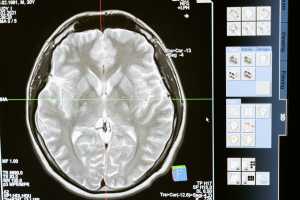Disclaimer: I am not a medical professional and none of the following should be construed as medical advice. This is information from one migraineur to another–please talk to your doctor before altering/starting/stopping any health plans.
Mommin’ on a Migraine: Survival Tips + My Hemiplegic Migraine Diagnosis
I have suffered from migraines for pretty much my entire life. I don’t know exactly when they started, but my guess is around nine years old. However, I didn’t receive a formal diagnosis of migraine until I was twenty-seven years old, mostly because migraines are very common in my family, so I was treated at home with Advil, Benadryl, and similar OTC medications. These medications worked for a while … until they didn’t.
One day, six months after I gave birth to my second daughter, something very strange happened while eating a bag of chips. I had recently started an anti-inflammatory diet in an effort to help with my autoimmune diseases, and this bag of sweet potato chips was new to me, and I started to feel “off.”
My vision was blurring, my fingers felt ice cold, and I couldn’t think straight. I drank a bunch of water and put the chips away. After about thirty minutes, I felt better. At the time, I did not associate these strange symptoms with food and chalked it up to being tired from breastfeeding my infant.
A week or so later, my husband was out of town for a business trip. I had just put the kids to bed, and I was sitting at my kitchen table talking to him over the phone about how he was going to have to stay in Chicago for an extra night due to a delayed flight. I don’t remember much else of the conversation. As we were ending the call, my vision blurred, my speech felt heavy on my tongue, and my limbs were tingling like TV static. The phone slipped from my hands and hit the table with a BANG!
The noise startled me enough to realize I needed help, and I needed it fast. I called my mom, trying to talk to her the best I could, telling her I needed someone to come sit with me. I had to push my words out of my mouth with great effort, stammering and stuttering against my will, and sometimes getting caught in my throat without any sound at all. This caused me to panic because I was fully aware of what I wanted to say in my brain, but my mouth would not cooperate.
My brother and sister-in-law came over immediately, and the rest is patched together in bits and pieces. I don’t remember any conversations, but I know they had to have happened. I remember trying to climb my stairs with my brother behind me, and I had to use both hands on one railing to create momentum so I could propel myself up one stair at a time. I don’t remember how I got in the shower, but I remember being in it, the hot water providing some relief to my throbbing, stabbing head. I don’t remember how I got out of the shower.

The next thing I remember is lying in bed, my room pitch black, and my brother bringing me Gatorade, Coke, water, and a plate of warm dinner. The smell of any type of food made me want to puke; the pain in my head was causing severe nausea but he knew I needed to eat. I remember forcing some food down and taking several different medications to try and relieve the pain, and eventually, I fell asleep. My sweet sister-in-law handled all of my baby’s night-wakings and made my kids breakfast in the morning so I could rest.
I found out later my brother had called my mom and told her he really wanted to bring me to the hospital because I didn’t look okay nor was I acting okay, but she felt certain it was a migraine and that it would pass. It did pass, but this was not the last time it would happen.
A few days later, I was sitting at my mom’s house with my kids playing at our feet. My brain felt fuzzy, but not too fuzzy like the night my brother came over. It felt like the day I ate those chips–and I had eaten them again this day. I hadn’t made this connection just yet, and again, assumed it was the breastfeeding-round-the-clock kind of fatigue messing with me. Then I opened my mouth to say something, and my tongue was stuck on the very first syllable of the first word. I just kept repeating the same sound over and over again, and I began to cry in frustration and panic. My arm lit up with ice, specifically my right side, and it felt next to impossible to move. Moving my right arm felt like I was dragging it through deep water–slow and difficult.
After thirty seconds of no speech and difficulty thinking clearly, it felt like my brain would short-circuit back “on” and my speech would flow freely and very quickly, like water breaking through a dam. My arm still remained cold and heavy, but I could talk and I could think. Then about thirty seconds later, a cloud formed in my brain and my speech halted again, and my panic escalated.
I began to cry, and all I could manage out of my mouth was sobbing “MOM!” She quickly called my husband (now back in town) and told him to come bring me to the hospital. She recorded me attempting to talk and move and sent it to him to show the doctors.
Diagnosis :: Hemiplegic Migraine
When we arrived at the ER, my husband did the talking as I was humiliated by my speech and quite frankly lacked the ability. As he told the front desk the reason for our visit, a nurse was watching me attempt to sign my name on the sign-in sheet. I couldn’t get my right hand to grip the pen tight enough, and the pen kept slipping. When I finally established a somewhat decent grip, I signed my name. Well, I thought I signed my name.
I looked down at the paper and saw nothing but scribbles. Literally just loops–no letters, no name. I looked at my husband and let out a loud cry to get his attention, and all at once the nurse watching me started screaming code numbers and my husband half-carried me into triage, bypassing the full waiting room completely.
I don’t remember much conversation. I remember holding out my arms a lot, I remember walking in a straight line, I remember lots of lights in my eyes. Labs were run numerous times over the next forty-eight hours. I had every type of scanning/imaging done, an epilepsy test, and even received a Catholic sacrament called the Anointing of the Sick. The doctors were convinced I was having a stroke, a TIA, or an aneurism.

But every single lab and every single test came back normal. My brain was clear of clots and tumors. On my third day in the hospital, a neurologist came to my room and informed me I had what is called hemiplegic migraine. He told me it was rare, and I needed established neurological care immediately. I was discharged with no other instructions because apparently there is no one treatment for these types of migraines. In fact, there’s no real “treatment” at all. Most people suffer with them their entire lives without relief.
I left the hospital thanking God I was still here. I truly believed I was about to be diagnosed with something fatal, and honestly, it is a miracle I wasn’t. I made an appointment with a neurologist, anxious to find out how I was supposed to raise my children and live my life with sporadic and detrimental stroke-like migraines. He told me I could take a preventative, everyday medication, but it had a forty-percent success rate and could not be taken while nursing a baby.
I declined and asked what alternatives I had. He told me the best thing was to take 800mg of ibuprofen the moment I felt “off,” and hope for the best because when you have been diagnosed with hemiplegic migraines, you can’t take the leading medications for migraines, which are triptans. Triptans increase the risk of stroke, and as someone with hemiplegic migraine, my risk of stroke is already much higher than the average person. These migraines also make it to that birth control is no longer safe for me to take because it too increases stroke and clot risks.
Identifying Triggers and Looking for Warning Signs
The other thing he mentioned was keeping a food journal, because most migraine sufferers have dietary triggers, and they’re different for everyone.
I began having these hemiplegic migraines SO often that I quickly figured out what my warning signs — commonly known as aura — were. Brain fog, a sudden wave of extreme fatigue, squiggly lines in my vision, and ice picks shooting up my right ring finger and pinky and into my arm. The moment any of the symptoms would show up, I would quickly take 800mg of ibuprofen and after thirty minutes or so, I would be able to talk and move around again, albeit very slowly.
I kept a food journal as suggested but felt lost: it seemed like nearly everything gave me a hemiplegic migraine. I was still sticking to an anti-inflammatory diet, but I hadn’t added anything new to my diet. In fact, I had done the opposite: I had removed nearly every processed food and drink in my previous diet, and it had been that way for months. What was going on?
My mom was working hard to help me figure out what my food triggers were, and one day, I brought a bag of those sweet potato chips with me to her house. I started to stammer my words mid-sentence and felt my face flush with frustration as I dug through my bag for some Advil. My mom asked for the bag of chips and began reading the ingredients, which I thought was odd — the only ingredients should be sweet potato and whatever oil it was fried in. Except, that wasn’t the case; there was an additional ingredient: maltodextrin.
At my mother’s urging, I made note of this added ingredient to my food journal. I really didn’t think anything of it, but she encouraged me to start checking the labels of everything I was consuming and recording every single ingredient. I thought this was overkill, but did it anyway. I was desperate for relief, and nothing else was working, so what did I have to lose?

Eventually, the food journal and its many, many lists of ingredients proved extremely useful–the culprit(s)? Maltodextrin, dextrose, MSG, and any of their substitutes/derivatives. These ingredients all come from corn, and my three children are all allergic to corn! They are also found in nearly all processed foods, which is why when I removed them from my diet for months but then unknowingly reintroduced them via sweet potato chips, my brain went haywire.
I learned we all have thresholds for certain foods in our bodies. Some thresholds are very low or non-existent, aka an allergy. Others are moderate, like an intolerance. Other thresholds are very high with little to no issues no matter how much of a food/ingredient you eat.
For me, my tolerance for these corn-based preservatives is extremely low, but I had been eating them every day my entire life–so my body became accustomed to the inflammation caused by them–hence my regularly-scheduled migraines since age nine. When I decided to eat an anti-inflammatory diet, I removed all processed foods and therefore MSG, dextrose, and maltodextrin.
The removal of them provided a lot of relief from migraines for several months, although I didn’t realize it at the time. The moment I ate those sweet potato chips though, I had reintroduced an ingredient my body has little to no tolerance for, and this time, my body fought back full-force in the form of a stroke-like migraine.
To this day, four years later, I still cannot eat any of these ingredients, even in the smallest amounts. I’m talking one chip, one bite, one lick…it doesn’t matter. My speech will slur and the right side of my body will become semi-paralyzed for hours until I take medication or my body finishes processing the food (which takes days). I have to painstakingly read every single label before I eat something out of a box or bag, and if I can’t find the ingredients or don’t know what’s in something (from a bakery, for example), I err on the side of caution and do not eat it.
So, after twenty years of migraines and four years of hemiplegic migraines, I consider myself an “expert” on how to manage symptoms while also carrying on with your life. After all, I can’t go lay down in a dark room every time I have a migraine–I stay at home with my three young children and cannot leave them to fend for themselves.
In this time, I have learned what works for me and what doesn’t work. Obviously, what works for me may not for you, but I wrote it all down for reference in case there’s something in here you haven’t tried yet!
My Migraine Routine
- take medication the moment you experience aura or recognize you are experiencing a migraine. DO NOT WAIT. Do not dismiss it as a “headache;” if you endure migraines, you don’t get “headaches.” It’s a migraine. I currently take ibuprofen as previously mentioned, but I also take Nurtec as a preventative and an abortive. This medication is not a triptan and, in my opinion, works much faster than anything else. It is prescription only, so ask your doctor! (NOTE: neither Nurtec nor ibuprofen are safe during pregnancy–see “Tips” section below)
- Drink lots of water, always, but especially during a migraine. While I’m waiting for the medication to kick in, I gather a cold water bottle and a cold Coke and take an extremely hot shower. I don’t even bathe–I sit in the shower, my head resting on my knees so the hot water can hit the back of my skull and neck. Alternate drinking water and Coke. Water for hydration, Coke for the caffeine–caffeine restricts your blood vessels, which helps alleviate pain. If you’re not a big Coke person, a hot cup of coffee or caffeinated tea after the shower will do the trick. But the key is to down that water while in the shower–an extremely hot shower is good for the pain, but will dehydrate you quickly if you do not keep up your water intake.
- In order to take a hot shower (relatively) uninterrupted, lay out a giant blanket and pillows in the living room (or whatever room is closest to your bathroom) and turn on a movie/offer tablets and turn off the lights. Ensure all doors are locked, baby gates are closed. Perhaps set your security alarm if you have a toddler who likes to escape when you’re not looking. Make sure everyone has a snack and a drink, and tell them what you’re doing: “Momma has a migraine, and I need to sit in the hot shower for a while. Please only come get me if you absolutely have to or someone is hurt.” Make sure to leave the door open enough to hear them and for easy access to you. If the kids are not cooperating, have them join you. If that’s not an option, it may be time to call a friend for extra hands.
- If you have a small infant, always bring them in the bathroom with you if you do not have another adult to care for them. I would bring the bouncer or Moses basket to keep my infant safe, and place them right next to the shower so I could pull back the curtain and reassure/comfort them if need be.
- After a hot shower and water/caffeine, put on extremely comfortable, loose clothing. Either make a Ziplock with ice and water or grab a bag of frozen veggies, and wrap it in a rag. The couch is now your best friend. Lay down, get cozy, and place the frozen bag either on the base of your skull or across your forehead. Make a second frozen bag if you need both areas covered for relief.
- Once you’re feeling up to it, it’s time to eat. By now, the medication should be kicking in. Be gentle with yourself for the next day or so–you’re now in the hangover stage. Order takeout, have zero guilt about screen time, and move slowly. Your brain just caught fire and is trying to rebuild!
TIPS:
- Peppermint essential oil is excellent for nausea. Keep smelling it, diffusing it, and/or apply to your wrists and temples of your head. It has a cooling sensation when applied to the temples and neck and provides pain relief.
- Bio-freeze roll-on is an excellent OTC topical medication for pain relief. It is similar to peppermint oil; it provides a cooling, tingling sensation when applied to the skin, but more intense.
- Magnesium supplements — specifically magnesium oxide — are helpful in preventing migraines. I take magnesium every night under the guidance of my doctor, so ask yours!
- If you are pregnant, 800mg of ibuprofen certainly isn’t an option, and Nurtec’s safety during pregnancy is currently unknown. Fioricet saved me during each of my pregnancies — this may be an option for you via your OBGYN.
- If you are experiencing migraines regularly, it is worth considering an appointment with an allergist. Foods are migraine “triggers,” and allergies also show up in the form of migraines. I was diagnosed with four different food allergies last year: shellfish, tree nuts, eggs, and oats; all of which I was eating regularly. Now that those allergens are removed from my diet, I get a migraine about once per week vs. every single day. I also get allergy shots once per week because I am highly allergic to pollen; so allergic I have to carry an epipen! I know for a fact my allergies contributed to my previously chronic migraine, so if you suspect the same, please seek out an allergist for relief!
















